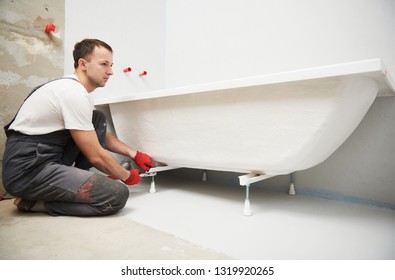Listed here down the page you will find lots of helpful insight relating to How to Install a Bathtub Yourself.

Mounting a bathtub isn't specifically rocket science, yet it does need strong plumbing, carpentry, and also often, tiling abilities. Changing an old tub with a brand-new one is likewise a reasonably tough job. If the old bathtub is easily obtainable, the project can relocate speedily; if you need to open up a wall to get rid of the old tub as well as position the new bath tub, the task is a lot harder. In either case, the job is within a residence handyman's skills, although you will certainly require an assistant to move out the old bathtub and also set in the brand-new one. Make sure you have certified yourself for the task as well as fit attempting it. Instead of working with a professional to take control of a halfway-completed project, it is much better to take into consideration employing one before you start. Opportunities are you may require a specialist plumber to make tube connections.
This short article will certainly assist you mount a new tub in your shower room if you have actually already purchased a brand-new bathtub and also do not need to alter the plan of your previous water system pipelines.
Your devices and also material checklist must consist of the following:
Removing Old Taps
If you need to replace old faucets with brand-new ones as a part of your installment, then the first thing you should do is detach the water system. After doing so, activate the faucets to drain pipes any water remaining in the system. The process of eliminating the existing faucets can be rather bothersome as a result of the limited access that is frequently the case.
Use a basin wrench (crowsfoot spanner) or a tap tool to reverse the nut that connects the supply pipes to the taps. Have a cloth ready for the remaining water that will come from the pipes. As soon as the supply pipelines have actually been gotten rid of, make use of the very same device to loosen up the nut that holds the faucets onto the bath/basin. You will certainly need to stop the single faucets from transforming during this process. Once the taps have been eliminated, the holes in the bath/basin will have to be cleaned of any old sealing compound.
Prior to carrying on to fit the new faucets, contrast the pipeline links on the old faucets to the brand-new faucets. If the old faucets are longer than the brand-new faucets, after that a shank adapter is needed for the new taps to fit.
Fitting New Taps
If the tails of the brand-new faucets are plastic, after that you will certainly need a plastic port to avoid damage to the thread. One end of the adapter fits on the plastic tail of the faucet and also the other end offers a link to the current supply pipes.
If you need to fit a monobloc, then you will certainly call for decreasing couplers, which connects the 10mm pipe of the monobloc to the standard 15mm supply pipeline.
Next, place the faucet in the installing hole in the bath/basin making certain that the washing machines are in place in between the faucet as well as the sink. Secure the faucet in position with the producer offered backnut. Once the faucet is safely in place, the supply pipelines can be linked to the tails of the taps. The faucets can either be linked by using corrugated copper piping or with normal tap connectors. The previous type should be attached to the tap ends initially, tightening only by hand. The supply pipelines can later be attached to the various other end. Tighten both ends with a spanner after both ends have actually been linked.
Installing the Bath tub
Utilizing the two wood boards under its feet, place the bath tub in the needed position. The wood boards are helpful in uniformly spreading the weight of the bath tub over the location of the boards instead of focusing all the weight onto 4 little points.
The following goal is to ensure that the tub is leveled all round. This can be achieved by inspecting the level as well as adjusting the feet on the tub till the spirit level reviews level.
To mount taps, fit all-time low of the furthest versatile faucet connector to the appropriate supply pipeline by making a compression join; after that do the same for the other faucet.
Switch on the water system and also examine all joints and brand-new pipework for leakages and tighten them if essential. Fill the tub as well as also inspect the overflow electrical outlet as well as the regular outlet for leaks.
Ultimately, repair the bathroom paneling as described in the producer's user's manual. Tiling and securing around the tub should wait up until the bath tub has been made use of a minimum of once as this will certainly settle it right into its last setting.
Planning for the Setup
To start with, the supporting framework supplied with the bathroom should be fitted (if needed) according to the maker's guidelines. Next, fit the faucets or mixer to the bath tub. When fitting the tap block, it is important to ensure that if the faucet features a plastic washer, it is fitted in between the bathroom and the taps. On a plastic bathroom, it is likewise reasonable to fit a supporting plate under the taps device to prevent stress on the bath tub.
Fit the versatile faucet adapters to the bottom of both taps utilizing 2 nuts as well as olives (occasionally supplied with the tub). Fit the plug-hole electrical outlet by smearing mastic filler round the sink electrical outlet opening, and then pass the outlet with the hole in the bathroom. Make use of the nut provided by the manufacturer to fit the plug-hole. Analyze the plug-hole outlet for an inlet on the side for the overflow pipe.
Next off, fit completion of the adaptable overflow pipeline to the overflow outlet. After that, screw the pipe to the overflow face which ought to be fitted inside the bath. Make certain you make use of all of the provided washers.
Link the trap to the bottom of the waste outlet on the bath tub by winding the thread of the waste electrical outlet with silicone mastic or PTFE tape, and screw on the catch to the outlet. Connect the bottom of the overflow tube in a similar manner.The bathroom should now prepare to be suited its final position.
Tiling Around the Bath tub
In the area where the bathroom satisfies the tile, it is required to secure the joins with a silicone rubber caulking. This is very important as the installation can relocate sufficient to split a stiff seal, triggering the water to permeate the wall between the bath and also the tiling, bring about complications with dampness and also feasible leaks to the ceiling below.
You can pick from a range of coloured sealants to blend in your components and also fittings. They are sold in tubes and cartridges, and also are capable of sealing gaps approximately a size of 3mm (1/8 inch). If you have a larger gap to load, you can load it with twists of soaked paper or soft rope. Bear in mind to always fill the bath tub with water prior to securing, to permit the motion experienced when the tub remains in usage. The sealant can fracture relatively early if you do not take into account this activity prior to sealing.
Conversely, ceramic coving or quadrant ceramic tiles can be used to edge the bathroom or shower tray. Plastic strips of coving, which are easy to use as well as cut to dimension, are likewise easily readily available on the market. It is suggested to fit the ceramic tiles using waterproof or water resistant adhesive as well as cement.
Bathtub Installation
How Important Is A Bathtub To Your Home?
High-quality baths, showers, and other bathroom updates are necessary when considering a smart investment in your home. It’s a room that you go to every day and one that is constantly being used by guests.The bathroom is one of the top trafficked rooms in a home and also one of the most valuable in terms of home resale.
Install Piping Before Tub
You will be using your existing drain and waste vent system, but pipes required include the hot and cold water supply lines and a pipe leading to a shower head. A mixing valve and shower head are also needed. Air chambers may be required.
Position the Tub
Lower the tub into place so that the continuous flange fits against the wall studs and rests on 1’x4' or 2’x4' supports. Anchor the tub to the enclosure with nails or screws inserted through the flanges into the studs.
NOTE: Remember, bathtubs and shower stalls may require support framing. A bathtub filled with water is extremely heavy, so check building codes and framing support before installing the tub.
Assemble Drain Connections
Assemble the bathtub drain connections by connecting the tub overflow with the tub drain above the trap, not beyond it. The trap will have a compression fitting that screws over the arm of the overflow assembly.
Place a Pipe For the Shower Head
First, locate a brass female threaded winged fitting and attach it to a framing support via a screw or a nail. Then run a pipe up the wall for the shower head. Sweat or solder the other side of the brass fitting to the top of the pipe.
Attaching Hot and Cold Water Lines
Attach your water lines for both hot and cold by sweating these directly into the hot and cold ports of the mixing valve. The mixing valve will be how water enters the tub’s system, not by the pipes themselves.
Install the Spout
Extend a piece of 1/2 inch pipe, or whichever length is specified in the manufacturer’s instructions, for the tub spout. Sweat on a male threaded fitting at the end of the pipe or use a brass nipple of the proper length and a 1/2 inch cap.
NOTE: At this point you should have your rough-in plumbing work inspected before proceeding further.
Check For Leaks
Restore the water pressure and check the drain connection and the supply pipes for any sign of leaking.
estore the Bathroom Wall
Replace the wall with moisture-resistant drywall as a base for your wall covering. Seal the joints between the wall and your new tub with silicone caulk as protection against water seepage.
https://www.berkeys.com/2016/12/02/bathtub-installation-dallas/

We had been shown that report on Tools You Need to Install a New Bathtub from a good friend on our other website. Be sure to take the time to distribute this write-up if you appreciated it. We cherish reading our article about A Step-by-Step Guide to Installing a Bathtub.
Estimating
 Barret Oliver Then & Now!
Barret Oliver Then & Now! Brian Bonsall Then & Now!
Brian Bonsall Then & Now! Tiffany Trump Then & Now!
Tiffany Trump Then & Now! Traci Lords Then & Now!
Traci Lords Then & Now! Catherine Bach Then & Now!
Catherine Bach Then & Now!